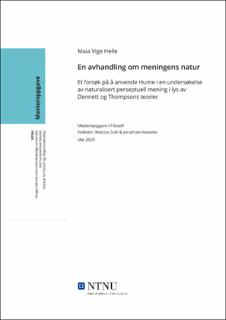| dc.description.abstract | Denne teksten undersøker muligheten for en naturalisert forståelse av fenomenet perseptuell mening, med utgangspunkt i David Humes filosofi.
Humes prosjekt kan forstås som et forsøk på å naturalisere mentale emner, og gi en vitenskapelig forklaring på bevissthetens struktur basert på hans førstepersons-undersøkelse av fremtredelser. I undersøkelsen av erfaringen skiller han ut noen viktige egenskaper som gjør assosiering mulig: vanedannelse og følelse. Disse er i følge Hume ikke unikt menneskelige egenskaper men deles av alle sansende vesener.
Påstanden om at egenskapene som gjør oss i stand til å erfare mening er før-intellektuell og ikke unikt menneskelig, kan sees som en sentral del av Humes naturalisering av sinnet. Hume gjentar at disse egenskapene må forklares av naturvitenskaper som anatomi, men gjør ikke dette selv. Dette etterlater denne jobben til de som vil fullføre arbeidet med å naturalisere erfaringen.
Thompson og Dennett kan sees som to kontemporære filosofer som arbeider innenfor det samme temaet med naturalisering av mentale emner, som Hume. Deres filosofi er i stor grad knyttet til vitenskapelig empiri, hvilket gjør dem bedre egent en Hume til å forklare hvordan meningserfaringen og -skapningen realiseres i kroppen. Dennett holder seg i stor grad til tredjepersonsperspektivet og er skeptisk til førstepersonsperspektivet. Thompson forener disse perspektivene, og kommer da i mitt syn nærmest å svare på Humes prosjekt, siden han etablerer mening i naturen uten at forklaringen står i veien for hverken naturaliseringen eller den fenomenologiske forståelsen av erfaringen. | |
| dc.description.abstract | This text explores the possibility of a naturalization of the phenomenon of meaning, especially perceptual meaning, taking the philosophy of David Hume as its point of departure.
Hume’s project attempts to naturalize topics concerning the mind, giving a scientific explanation of the contents of consciousness based on his first-person access to appearances. In explaining the basic function of consciousness which makes us able to experience perceptual meaning, he identifies some central features of the mind that underlies this function: habit, and feelings. These, Hume claims, are not uniquely human abilities, but are shared with all sensible creatures.
This claim, that the basis for our sense-making abilities is pre-intellectual and not uniquely human, can be seen as a central part of his naturalization of the mind. Hume repeatedly says that these basic abilities of sensing and feeling must be explained by natural philosophy (or science), such as anatomy, but he himself doesn’t go into this topic. This leaves the task of working out how these abilities came about, and how they are realized in the body physically both in humans and in other organisms.
I argue that there is a duality in Hume’s method – which in my view is an important part of the naturalization of the mind – which causes some vacillation both concerning the principles he bases his theories on, and his description of the phenomena. On the one hand he bases his research on the methods and ideals of natural science: objective observation, and reductionism. On the other hand, he takes what we today can call a phenomenological approach, exploring the objects in his consciousness and describing them to explain the basis for all knowledge, including science. This leads him to the view that everything in the mind, including impressions, is reducible to simple “atoms,” while he also, in describing certain examples, argues that we experience objects as wholes that can only be “reduced” in thought but never in our immediate impression.
Hume has thus left us with two challenges that must be dealt with in order to see the potential of his findings in today’s philosophical debate about naturalizing the mind: first, to find a solution to the inconsistencies in his description of impressions; secondly, the possibility for a scientific approach to consciousness. In order to deal with these challenges, I will go to three contemporary philosophers who can be said to further develop Hume’s project as described above: Merleau-Ponty, Dennett and Thompson. While none of these philosophers relate directly to Hume, I will try to demonstrate how key tenets in their thoughts can be read as accomplishments of various aspects of Hume's vacillating theory.
In my reading, Merleau-Ponty comes with a possible solution to the duality in Hume’s explanation of impressions by explaining the contents of consciousness as non-reducible gestalts, which cannot be reduced to 'simple impressions' without losing their meaning. He also differentiates between human and animals’ experience of meaning. Dennett and Thompson provide answers to the second “lacking” in Hume’s explanation by giving a naturalistic basis for perceptual meaning by grounding it in biology and anatomy. And they also have a way of explaining the difference between humans and animals without separating them completely so that the connection Hume sees between all living things is preserved. Dennett does this naturalization of the mind by separating the idea of meaning from the phenomenological description of it. Thompson keeps Merleau-Ponty´s phenomenological definition of meaning and idea of structure and unites it with knowledge form modern natural sciences.
Thompson then, in my view, comes closest to answer to Hume’s overall project with his attempt to naturalize phenomenology and explain all the elements that Hume left open or ambiguous by replacing the idea of reduction with the idea of structure as the central idea behind naturalism. | |
